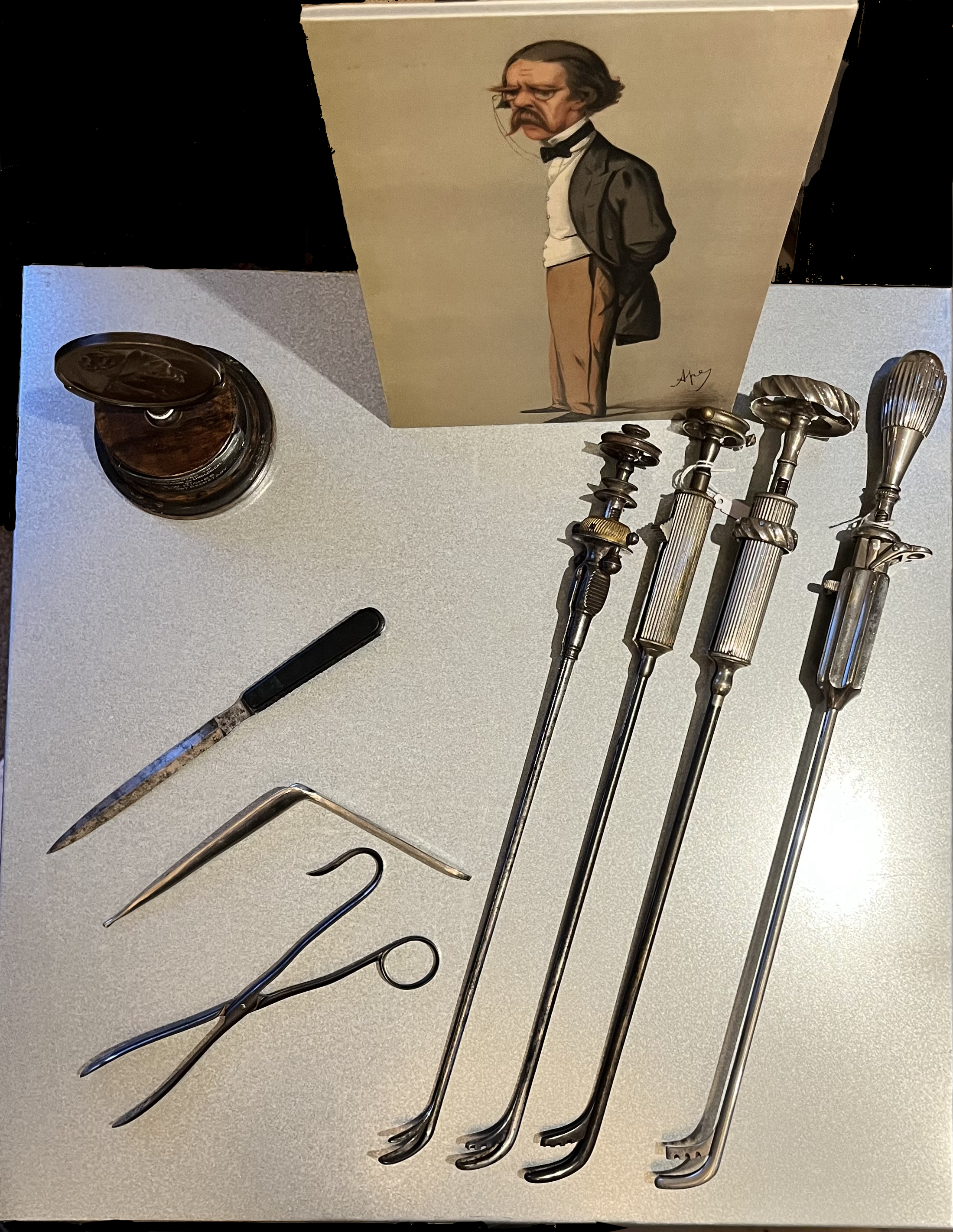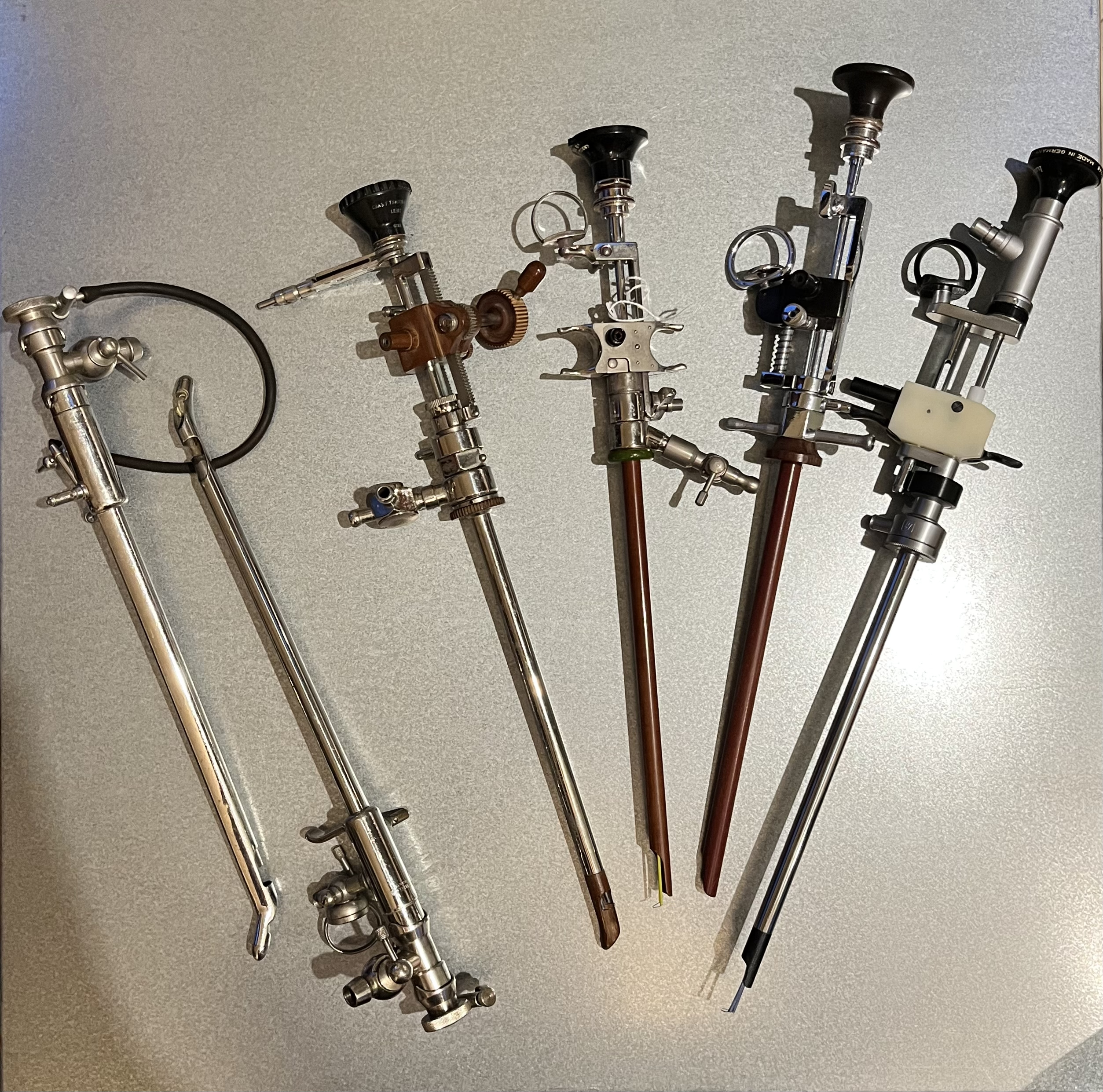Hosted by Urology News
BAUS Manchester 2025 saw a return of the BAUS Museum Display, this year kindly hosted on the Urology News Stand. Since 2011,
Urology News has published a History Column highlighting artefacts and stories in the BAUS Museum of Urology. The artefacts in the display link with and re-visit some of these past articles
PLEASE NOTE: click on any image to view a full screen version
2.jpg) Top Shelf
Top Shelf
Here we revisit the worlds of Ancient Greece and Rome, the beginings of recorded medicine and urology, in the Western World at least. The modern statues are of Hippocrates c.460 - 370BC and of the Roman god Priapus. Gods, religion and faith have always been important in the history of medicine. The penile amulets are original circa 3rd-4th centuryAD. They were worn as good luck charms, but may also have been a request to the gods to heal genital problems.
Also on this shelf are a selection of catheters. From the top down: Freyer evacuating catheter, Modern Foley cathteter on a Maryfield introducer, Black Gum Elastic Catheter by Thackray, Red Rubber Tiemann tip catheter by Geo Tiemann & Co., Vertebrated catheter, Two silver male pattern cathteters, Glass female catheter, Silver female extending catheter & a modern ISC catheter.
 Second Shelf
Second Shelf
The second shelf celebrates historical bladder stone surgery. On the left are instruments for performimg open perineal lithotomy, the most ancient of urological operation; a double edged bistuary (knife), a gorget (to open the wound into the bladder) and bladder stone forceps. Behind is the Cheselden Medal. William Cheselden (1688 - 1752) was one of the greatest practitioners of perineal lithotomy, it is said he once removed a stone in 54 seconds.
On the right are a selection of lithotrites. Lithotrity and later litholapaxy was the first minimally invasive operation (from 1824). Lithotrites are passed blindly into the bladder, the stone is grasped and crushed and the patient then voids the fragments; later they were washed out (e.g. using the Freyer evacuator on the top shelf).
At the back is a copy of a cartoon of Sir Henry Thompson (1820 - 1904) one of Britain's most skilled operator with a blind lithotrite.
Lithotrites, from left to right; Jean Civiale model, Sir Henry Thompson model, Herbert Milton model & Henry Bigelow model.
 Third Shelf
Third Shelf
The third shelf is all about transurethral prostatic surgery. This is not just about TURP.
On the left are two prostatic punches. The punch prostatectomy emerged before TURP, the first real punch was designed by Hugh Hampton Young (1870 - 1945), known as the father of American urology. The instrument is passed down the urethra and into the prostatic cavity. A window opens in the side allowing a portion of prostatic tissue to fall in; then a sharpend metal cylinder slides forward and cuts it off. The significant bleeding soon led to the addition of bugbee electrodes for haemostatis. On the far left is an American Gershom Thompson punch, one of the most popular models. Next to it you will see one with a thumb ring added. This was the addition of John Swinney (1912 - 1988) of Newcastle, it allowed much easier and smoother use.
To the right of these are a seletion of resectoscopes. TURP was first introduced in 1926 by the American Maximillian Stern (1843 - 1946). His early resctoscope was much improved by Theodore Davis (1889 - 1973) and Joseph McCarthy (1874 - 1965) and the Stern-Davis-McCarthy resectosope became the most popular model for decades. Many urologists soon added their own models and adaptations. The ones here, from left to right are: Terence Millin's adapation of a McCarthy model, John Mitchell's (Bristol) resectoscope, a Frank Raper model (Leeds) and Turner-Warwick resectoscope.
Read more about the history of TURP from BAUS 2019 Glasgow
.jpg) Bottom Shelf
Bottom Shelf
Finally, a teaser for the next Urology News History column ...
One of the reasons for the creation of the Museum of Urology was to bring together collections of urological Instruments from hospitals & private collections throughout the country, so anyone could share them and see them easily. These collections, both large and small, have been photographed so they can remain in their hospitals (or with their owners), whilst also being showcased in the Museum.
Some instruments, documents and photographs have been kindly donated to the museum for safekeeping and future study. Recently, two boxes of instruments and pictures were donated by the family of Philip Clark, a former Consultant Urologist from Leeds. This generous donation has been used to tell the story of the history of urology in Leeds and the history of British urology as a whole. These instruments and artefacts will continue to help us further understand the history of urology, our speciality. They include a pelvic self retaining retractor modified by Prof Leslie Pyrah, Pyrah's pedicle clamp for use in cystectomy, a Braasch (direct vision) cytoscope used by Pyrah, a Riches suprapubic "stab'"catheter introducer, Fergusson bladder tumour forceps on an original painting of a cystectomy specimen removed by Pyrah in the 1940's.
The postcard (top left of the image) is an original photograph of Leeds Infirmary, circa 1906.
Past Urology News History articles are available from the Urology News Website, and many are kept in the Museum of Urology Library